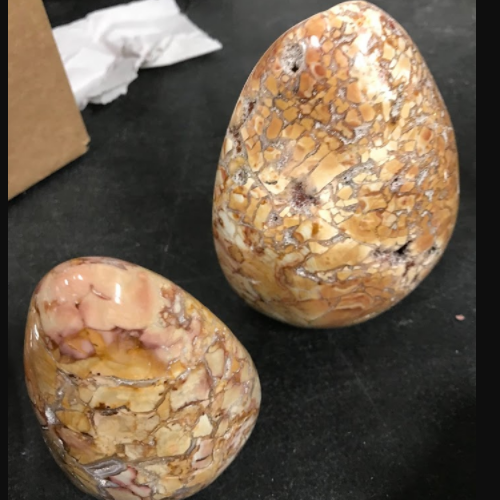Product Description
Turquoise Polished Freeform - Select
Size : 1.5-2 "W x 2.5 - 3.5"H
Country of origin: Peru
Mineral Information:
Turquoise is a mineral and a gemstone that is highly valued for its distinctive blue-green color. It is formed by the chemical combination of copper, aluminum, and phosphorus, and belongs to the mineral group known as phosphates. Here are some key characteristics and information about turquoise:
-
Color and Appearance: Turquoise is renowned for its unique blue-green color, which can range from sky blue to greenish-blue. The color is often attributed to the presence of copper in its composition. The stone can display varying degrees of color intensity, with the finest specimens being vibrant and saturated. Turquoise is typically opaque, but it can sometimes exhibit a translucent quality.
-
Origin: Turquoise is found in several regions around the world, including Iran (historically known as Persia), the southwestern United States (notably Arizona and New Mexico), China, Egypt, and Mexico, among others. Different locations can produce variations in color, matrix patterns (veining or host rock inclusions), and overall quality.
-
Historical Significance and Cultural Importance: Turquoise has a rich history and has been highly regarded by various civilizations throughout time. It has been used as a decorative stone, jewelry material, and amulet for thousands of years. Many ancient cultures, including the Egyptians, Persians, Native Americans, and Tibetans, believed in the protective and healing properties of turquoise.
-
Uses and Jewelry: Turquoise has long been used in jewelry making and ornamental objects. It is often cut and polished into various shapes, including cabochons (smooth, rounded tops), beads, and inlays. Turquoise jewelry, such as rings, bracelets, necklaces, and earrings, remains popular today, appreciated for its vibrant color and cultural significance.
-
Care and Durability: While turquoise is relatively durable, it is considered a moderately soft gemstone with a hardness of around 5 to 6 on the Mohs scale. It can be susceptible to scratching and damage from hard impacts or chemicals. Proper care includes avoiding exposure to harsh chemicals, prolonged sunlight, and extreme temperature changes. Cleaning turquoise jewelry with mild soap and water, and storing it separately from other gemstones, can help preserve its beauty.
Metaphysical Meaning:
Turquoise is often considered a stone of protection, enhancing spiritual insight, and promoting balance and harmony. Turquoise is also believed to bring good fortune, luck, and prosperity. In some traditions, it is regarded as a stone of communication, encouraging honest expression and effective communication skills.
Mineral Care:
Turquoise is considered a relatively soft gemstone, and its fragility should be taken into account when handling and caring for it. Here are some factors related to the fragility of turquoise:
-
Hardness: Turquoise has a hardness of around 5 to 6 on the Mohs scale of mineral hardness. This rating indicates that it is softer compared to many other gemstones commonly used in jewelry. Its relatively low hardness makes turquoise more susceptible to scratching and abrasion from daily wear, contact with other materials, or rough handling.
-
Porosity: One characteristic of turquoise is its porosity, which means it has tiny spaces or pores within its structure. This porosity can make turquoise more vulnerable to damage from chemicals, oils, and prolonged exposure to water. Turquoise can absorb substances that may affect its color, stability, or overall appearance. It is important to avoid contact with substances such as perfume, lotions, and household cleaners that can potentially harm the stone.
-
Stability: Turquoise is sensitive to changes in temperature and rapid environmental fluctuations. Extreme heat or rapid temperature changes can cause thermal shock, leading to cracks or fractures in the stone. Turquoise is also sensitive to sunlight, which can cause fading or discoloration over time. Therefore, it is advisable to protect turquoise jewelry from prolonged exposure to direct sunlight or extreme temperature conditions.
-
Impact and Pressure: Like other gemstones, turquoise can be susceptible to breakage or chipping if subjected to strong impacts or pressure. Care should be taken to avoid dropping or banging turquoise jewelry against hard surfaces. It is recommended to remove turquoise jewelry during activities that may pose a risk of impact or pressure, such as sports or heavy manual work.
To minimize the fragility-related risks associated with turquoise, it is important to handle it gently and with care. Here are some general guidelines for caring for turquoise:
- Store turquoise jewelry separately in a soft pouch or jewelry box to prevent scratching or damage from contact with other gemstones or harder materials.
- Avoid exposing turquoise to harsh chemicals, including cleaning agents, as they can potentially cause discoloration or deterioration.
- Clean turquoise jewelry with a soft, dry cloth or a mild soap solution, gently wiping the surface to remove any dirt or oils.
- Protect turquoise jewelry from prolonged exposure to direct sunlight and extreme temperature changes.
- Consider restringing or inspecting turquoise bead necklaces periodically, as the stringing material can wear out over time and increase the risk of breakage.
By following these guidelines and treating turquoise with care, you can help preserve its beauty and integrity for years to come.
Disclaimer:
No information here is intended to diagnose, treat or cure ailments or afflictions of any kind. One should always consult a medical professional if a serious issue presents itself.










